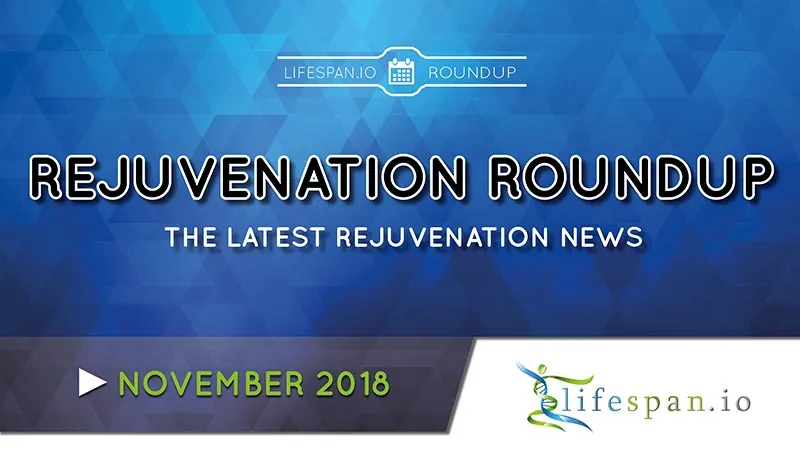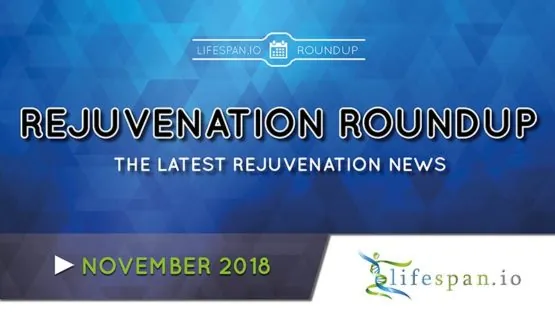‘Tis the season to be jolly, friends of healthy longevity! Time to dim the lights, gather around a crackling fireplace, cuddle up into a warm blanket, and recap the rejuvenation news of last November.
LEAF News
Highlight: Keith at The Young Turks
LEAF President Keith Comito will have a lot of sleep to catch on once rejuvenation therapies finally reach the clinic—right now, he’s too busy building bridges to a world free of age-related diseases to get a little shuteye, and getting the word out through as many outlets as possible is part of the job description. Among his many outreach efforts, he was recently featured on The Young Turks, a popular American news and commentary YouTube channel with a following of over four million people; during his chat with host Cenk Uygur, Keith discussed the science of healthy life extension and Lifespan.io’s mission to crowdfund the cure for aging. It was great to see that Cenk was 100% onboard with the cause, and if you are too, a super simple, effective, and zero-cost way to help the cause is to share the video below on all your social media!
Team and activities
NAD+ Mouse Project wrap-up. The NAD+ Mouse Project came to a conclusion in early November, and thanks to our generous supporters, it was an amazing success! The donation meter reached far beyond the initial goal of $30,000, smashing the third stretch goal and hitting an incredible $75,285! Our deepest gratitude goes out to everyone who helped make this possible! Thank you also from Dr. David Sinclair, who commented: “We are both humbled and so very grateful for the generous support of the NAD mouse project. As the excitement and potential of the NAD longevity field continues to grow, we can’t wait to see what we learn and report to our supporters about what NMN can do.”
Stay tuned for our next campaign!
Podcast: Ryan O’Shea of the Future Grind podcast returns to bring you the November edition of the Rejuvenation Roundup podcast.
LEAF at EHA. The Fourth Eurosymposium on Healthy Ageing, a biannual event organized in Brussels by the Healthy Life Extension Society, took place from November 8 to November 10. The conference featured a number of interesting talks by leading scientists on the topics of cell senescence, proteostasis, and DNA repair as well as panels and talks about advocacy as well as social and financial issues related to rejuvenation.
Journal Club. November’s Journal Club saw the discussion of a paper on the link between cellular senescence and tau protein aggregation in the brain, one of the key factors in Alzheimer’s disease.
Lifespan.io interviews
Leonid Gavrilov and Natalia Gavrilova. The two well known biodemographers of aging had a chat with us about the possible effects of vastly extended lifespans on the population as well as other, broader questions related to aging and life extension.
Events
Undoing Aging 2019. The second instalment of the Undoing Aging conference series is getting closer and closer, and the list of amazing speakers that it will feature was recently updated last month and just keeps growing! Next year in Berlin, you’ll have a chance to meet Dr. Julie Andersen and Dr. Judy Campisi from the Buck Institute for Research on Aging, Dr. Jerry Shay from the University of Texas Southwestern Medical Center, Dr. Ruby Yanru Chen-Tsai from Applied StemCell, Inc., and many more! If you plan on offering a presentation of your own, the deadline to send in an abstract is January 31.
SRF winter fundraiser. SENS Research Foundation, the engine room of multiple rejuvenation biotechnology initiatives, is running its traditional winter fundraiser, which is due to terminate on December 31. The fundraiser’s goal is $500,000, and the meter currently stands at just over $183,000 in no small part thanks to Jim Mellon’s generous donation of $100,000. In addition, Josh Triplett, Christophe and Dominique Cornuejols, and Fight Aging! have also put together a matching fund of $54,000 to match the next year of donations of any new SRF patrons who pledge a monthly donation. If you want to help SRF in its quest to bring aging under full medical control, here’s your chance!
The Longevity Forum. The first Longevity Forum, an initiative by investor Jim Mellon, was held in London on November 5th; the event brought together illustrious figures of the rejuvenation research and investment landscape, such as President of the Buck Institute for Research on Aging Eric Verdin, AgeX Therapeutics CEO Mike West, and Jim Mellon himself. As stated on its website, the Forum “aims to explore and establish new ways of addressing opportunities/issues related to longevity by displaying proof of concept”. You can read a firsthand report by Fight Aging!‘s editor Reason, who attended the event.
Longevity Leaders. The Longevity Leaders Conference will take place next February in London and will see our own Steve Hill as a panel moderator. As always, you can expect interviews and event coverage, so keep an eye on the blog!
Longevity Therapeutics. Yet another event of interest that we discussed last month was the Longevity Therapeutics Summit, which will be held in San Francisco at the end of January. Speakers of the caliber of UNITY‘s Dr. Nathaniel David and Buck Institute Professor Judith Campisi will be present, so you might want to attend as well.
Research roundup
Cellular senescence
Two known antibiotics as potential senolytics. A paper by scientists from the University of Salford suggests that the known antibiotic drugs azithromycin and roxithromycin may have senolytic effects, as they appear to target senescent human fibroblasts. The study was conducted in cell cultures, and as Fight Aging! points out in a short commentary, it is too early to say whether the same effects observed in vitro will translate to animals—or people.
Smart bombs against senescent cells. Senolytic Therapeutics is one of the many biotech startups working on a particular approach to effectively remove excess senescent cells from the body. Its approach has been likened to “smart bombs” by Michael Rae on SRF’s blog in that, while the chemotherapeutic load of the drug is capable of killing any cell to which it is delivered, it is encapsulated within a nanotube that can be unlocked only by senescent cells. Further commentary can be found in this article by Fight Aging!
Loss of proteostasis
AMBAR to slow down Alzheimer’s. A new therapy known as AMBAR has been shown to significantly slow down the progression of Alzheimer’s disease during a phase III clinical trial; even though AMBAR is not a cure for the disease, it is still a significant step forward, and it should become commercially available following FDA registration within the next few years.
Geroneuroprotectors against Alzheimer’s disease. Geroneuroprotectors are a subset of geroprotectors that have shown promise in terms of their ability to slow down aging in mice, particularly the effects of Alzheimer’s disease. In a study by the Salk Institute, researchers focused their efforts on three compounds that they synthesized from fisetin and curcumin, and they are now hoping to get two of these compounds into human clinical trials.
Deregulated nutrient sensing
mTORC1, type 2 diabetes, and aging. A recent paper, commented on here by Fight Aging!, discusses the hyperactivation of the mTORC1 pathway that is observed in both type 2 diabetes and aging; aging increases the likelihood of developing type 2 diabetes, while type 2 diabetes can exacerbate other aspects of aging.
Other
Longevity isn’t all about genetics. A paper published in early November suggests that the genetic contribution to human longevity, traditionally estimated at up to 30%, is even lower than that—under 10%.
Dysfunctional immune system connects gut bacteria and aging. An experiment on fruit flies showed that disrupting the insects’ immune system by knocking out the PGRP-SD gene, which is responsible for the recognition of foreign bacteria and the consequent immune response, resulted in higher levels of Lactobacillus plantarum in the flies’ guts. These bacteria produce lactic acid, and without the immune system effectively purging them, the production of this acid increased substantially, causing tissue aging and reduced lifespans. Increasing the production of PGRP-SD had the opposite effect.
Measuring aging biomarkers with a lab on a chip. Keck Graduate Institute scientists have developed a system called Click-A+Chip, which is a palm-sized testing system capable of measuring changes in blood proteins associated with aging, thereby assessing the decline in tissue health and functionality. This new system promises to be much faster and cheaper than traditional methods.
Klotho mitigates brain inflammaging. Gladstone Institutes scientists found out that the natural decrease in the expression of the klotho gene in the choroid plexi of mice allows inflammatory molecules to more easily reach the brain, increasing brain inflammation and impairing brain functions. The researchers think that klotho depletion might also be to blame for brain inflammaging in humans, and they plan to study whether increasing klotho in the choroid plexus of the brain might help suppress the cognitive decline associated with aging.
The decline of NAD+ with age. A small-scale study recently showed that NAD+ in human plasma tends to decrease with age, though it remains to be seen whether this happens because of increased consumption or decreased production of the molecule.
Boosting A. muciniphila gut bacteria reduces insulin resistance. A study in the journal Science Translational Medicine shows that increasing levels of the bacterium Akkermansia muciniphila helps in reducing insulin resistance in both mice and monkeys. Mounting evidence suggests that these bacteria play a role in the prevention of age-related conditions such as cancer and type 2 diabetes. According to the study, older monkeys showed decreased levels of the bacteria, resulting in lower levels of a protective molecule known as butyrate, thereby contributing to the thinning of the animals’ intestinal walls. The resulting leaky gut eventually leads to higher levels of chronic inflammation and insulin resistance. The scientists think that increasing this bacterium in the human gut might be a viable therapeutic avenue for the prevention of several age-related conditions.
News nuggets
Epigenome editing on LLL. The epigenome series on LLL continues, with part 4 having been published on November 9; the full series can be found here.
Sequencing the genome of your pet. In this article, Neo.Life‘s Grace Rubenstein explains the potential benefits of sequencing the genome of pets—not just for pets themselves, but also for us humans.
CRISPR babies. Recently, Chinese researchers have announced the first CRISPR-edited babies with engineered resilience against HIV. As expected, the announcement has stirred controversy, but it was also a good opportunity to discuss why designer babies might be a good thing after all.
Coming up in December
Project4Awesome 2018. An initiative of the Foundation to Decrease World Suck, Project4Awesome is a contest in which charities from all over the world can win large monetary prizes to carry out their charitable activities. Everyone is invited to produce YouTube videos of any budget to endorse their favorite charities, and viewers’ votes decide the winners—yes, there’s more than one. Lifespan.io will participate as well, so we encourage all our fantastic supporters to muster their artistic talents and make videos to show everyone why you believe in us!
P4A will livestream from December 7 to December 9, and if your video is particularly interesting or well-made, it might be featured on the show! You can submit your creations starting on December 5 at midnight EST until the very end of the livestream at 11:59 AM EST on December 9.
That was all for November, and a very busy month it was! We wish you and your loved ones a happy holiday season; the roundup will be back for December as well as our yearly roundup for 2018.





